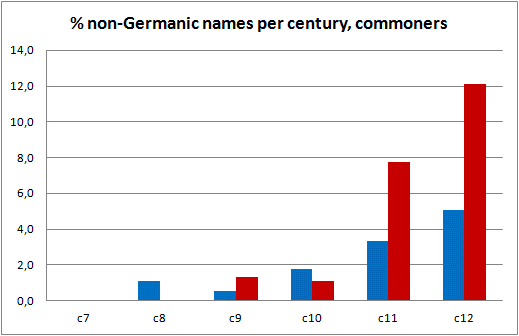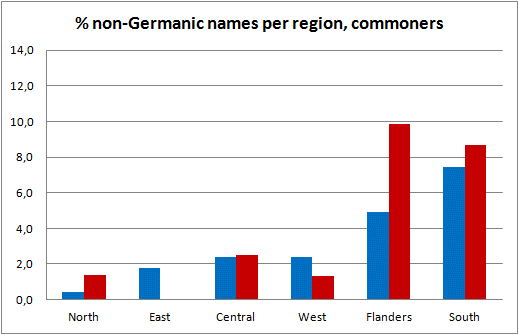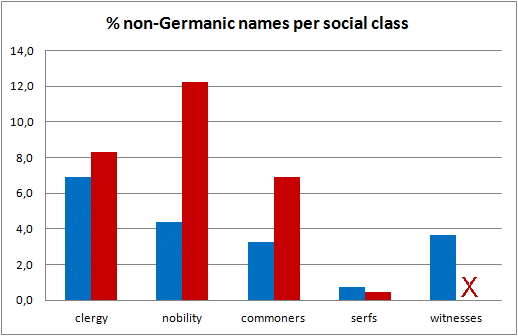In the early Middle Ages the vast majority of the people in the Low Countries had a Germanic name.
There were also names taken from the Bible, the Greek mythology or Celtic literature, but these were unusual: only 4% of the men and 6% of the women had a non-Germanic name.
This page shows that four factors influenced the frequencies of non-Germanic names: time, gender, region, and social class.
Non-Germanic names over time
The percentage of non-Germanic names among men was relatively high in the first centuries; in the 9th century it dropped sharply, and then it slowly increased again. Among women the percentages of non-Germanic were initially low, and they showed an increase through the centuries.
The total picture among men was heavily biased by the fact that during the first centuries relatively many clerics were registered. Many preachers and the first bishops in the Low Countries came from countries far away and they sometimes bore exotic names. In the case of Bonifatius we know that his actual name was Winfried. Maybe other clerics also assumed a pious name although originally they had an ‘ordinary’ Germanic name. Anyway, they pushed up the percentage of non-Germanic names, but they did not necessarily reflect the pattern among the population as a whole.
The number of female clerics was low, so there was no bias among the women.
In order to exclude the influence of social classes on the total pattern, only the figures for the common people have been depicted below. Both among male and female commoners the frequency of non-Germanic names showed a steady increase.

Figure 1. Percentage non-Germanic names among common people for men (blue) and women (red).
After 1150 the changes continued. In the compilation of the late 13th century, one in every three persons had a non-Germanic name.
(1)
Non-Germanic names and gender
Figure 1 shows a clear cut difference between male and female commoners in the later centuries. In total, female commoners carried a non-Germanic name twice as often as the males. Among the nobility the difference was even a factor three. Among clerics, the percentages were relatively high in both sexes, and among the serfs relatively low. The residual class (‘witnesses’) contained too few women to allow a comparison.
(2)
Van der Schaar (1953, p. 42 and 105) stated that the shift towards non-Germanic names occurred earlier among women than among men.
The present analysis does not support this.
From the compilation it does not appear that the increase started earlier among women than among men: in both sexes, non-Germanic names were very rare in the 7th and 8th centuries, they occurred occasionally in the 9th and 10th centuries, and there was an obvious rise the 11th century, which continued in the 12th century. The only gender difference was that the increase among women, once it had taken off, was stronger than among men. This resulted in a higher total percentage among women.
In the 13th century this difference became even more outspoken.
(3)
Van der Schaar added, that the difference would have been caused by less conservatism on the part of the parents in the case of a daughter. This may indeed have been of influence. Another explanation that could be suggested is the habit of (some) noblemen to import their brides from far away, thus introducing new, exotic names into the Low Countries. However, this did not occur among the ordinary people, and still the girls had more non-Germanic names.
Non-Germanic names per region
In Figure 2 it can be seen that the frequencies of non-Germanic names varied widely between the six regions.
(4)
Flanders and the South had the highest scores, while non-Germanic names were exceptional in the North and East.
In the 13th century, this regional variation was still noticeable.
(5)
Apparently, the Northerners remained faithful to their traditional Germanic names.

Figure 2. Percentage non-Germanic names per region for men (blue) and women (red).
Recently, the differences within the region West were analysed in more detail by Schoonheim.
(6)
For 13th century women she found considerably fewer non-Germanic names in North Holland than in South Holland and Zeeland.
Thus, Schoonheim corroborated the pattern which I had assessed a few years earlier in my study of 13th-century names, not just for women but also for men.
(7)
The numbers of women before the 13th century were too low to draw any conclusions, both in Schoonheim’s study and in mine.
The present compilation did contain enough men to allow a statistical test. Within the region West there was a small difference before 1150 (North Holland: 3%; South Holland and Zeeland: 4%) but this was not significant.
(8)
In conclusion, the emergence of non-Germanic names appears to have started in southern Holland before 1150, but not to such an extent that there was a noticeable difference with northern Holland. After 1150 a clear difference would develop: the process of 'de-Germanisation' continued in South Holland and Zeeland, but found relatively few followers in North Holland.
Non-Germanic names and social class
The differences between the social classes regarding non-Germanic names have already been touched upon .
Figure 1 shows that among nobles and clerics, non-Germanic names were relatively popular, and that among serfs they were virtually absent. These differences appeared both among men and women.
(9)

Figure 3. Percentage non-Germanic names per social class for men (blue) and women (red).
Nordic names
The Nordic names registered here have been included in the tables and lists as Germanic names, since Scandinavia belonged to the Germanic area. The Vikings paid regular visits to the Frisian and Flemish shores, but in the given names this is hardly visible: the typical Nordic element Chnuz (Knut) appeared twice, and Staina in 13 names (both as first and as second element). Remarkably, almost all of these 15 names were found in the regions Flanders and South (only Knut came from the Eastern region). In the Northern region, where one might have expected the strongest Scandinavian influence, these name did not occur.
(10)
Notes
1 - Names in the Low Countries 1250-1300.
2 - Percentages non-Germanic names for men and women resp. among clerics: 6,9 and 8,3; nobility: 4,4 and 12,2; commoners: 3,3 and 6,9; serfs: 0,7 and 0,5; witnesses: 3,6 en undetermined.
3 - Difference between the sexes regarding non-Germanic names in the 13th century:
men 32,9%; women 41,9%; X²=16,52, df=1, p<0,001.
Names in the Low Countries 1250-1300.
4 - Differences between the regions regarding non-Germanic names (region Frisia excluded from the analysis):
Men X²=45,52, df=5, p<0,001.
Women X²=12,08; df=5; p<0,05; region North and East combined: X²=12,01, df=4, p<0,02.
5 - Names in the Low Countries 1250-1300.
6 - Schoonheim, (2004, p. 257).
N.B.: The term ‘Holland’ refers to the western provinces of The Netherlands, and not to the nation as a whole.
7 - Names in the Low Countries 1250-1300. First version of the website: 2003.
8 - Difference within the West regarding non-Germanic names among men until 1150:
North Holland: 3,1%; South Holland and Zeeland: 4,1%; X²=0,36, df=1, NS.
Analysis over 465 men of whom the location within the region West could be determined.
9 - Difference between the social classes regarding non-Germanic names:
Men X²=30,39, df=4, p<0,001.
Women X²=18,75; df=3; p<0,001 (class ‘witnesses’ excluded).
10 - Only persons that resided in the Low Countries for a longer time have been included in the present compilation.
An overview of all attestations of Vikings who called at our coasts once or twice, contains more names:
see Nordic names in the Low Countries.
|



